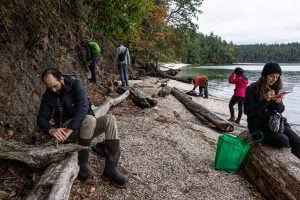
Environment
The sixth extinction
The planet is in the midst of drastic biodiversity loss that some experts think may be the next great species die-off. How did we get here and what can be done about it?
- 4895 words
- 20 minutes
This article is over 5 years old and may contain outdated information.
Wildlife

Cory Sheffield has been stung hundreds of times, but he keeps coming back for more. “You get used to it,” says Canada’s foremost bee expert.
Since his work as curator of invertebrate zoology at the Royal Saskatchewan Museum began a year and a half ago, Sheffield has added a dozen new bee species to the museum’s records, bringing the number of bee species in Canada to just under 800.
It’s not surprising that Sheffield ended up in his current position. While growing up in Nova Scotia’s Annapolis Valley — an agricultural area full of apple orchards, vegetable crops and berry bushes — he spent a lot of time gathering beetles and looking at insects in jars. “I knew I wanted to work in natural history,” he says.
He might never have guessed, however, that he’d be a part of natural history. Sheffield was recently immortalized in the world of bee taxonomy when a new species, mexalictus sheffieldi, was named after him. He’s named a few himself, too, including a species of Texan leaf-cutter, which he dubbed megachile chomskyi, after linguist and political commentator Noam Chomsky (the bee had a long tongue).
Sheffield is currently studying how to sustain bee populations and help the crops they pollinate, such as apples, by providing the insects with year-round food sources. He says that although bees will eat from apple flowers, the fruit’s bloom only lasts one week, leaving bees with nothing to sustain them for the rest of the year. Sheffield believes that if different kinds of flowers and food sources are grown near apple orchards, higher bee populations could be sustained. And a world with a healthy bee population would indeed be his land of milk and honey.
Are you passionate about Canadian geography?
You can support Canadian Geographic in 3 ways:

Environment
The planet is in the midst of drastic biodiversity loss that some experts think may be the next great species die-off. How did we get here and what can be done about it?

People & Culture
Naming leads to knowing, which leads to understanding. Residents of a small British Columbia island take to the forests and beaches to connect with their nonhuman neighbours

Wildlife
To save the bees, we first need to understand them — and recognize their value independent of their role as pollinators

Wildlife
An estimated annual $175-billion business, the illegal trade in wildlife is the world’s fourth-largest criminal enterprise. It stands to radically alter the animal kingdom.